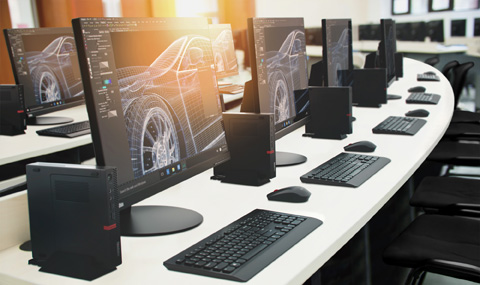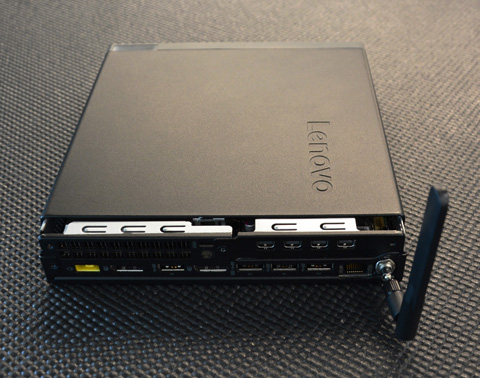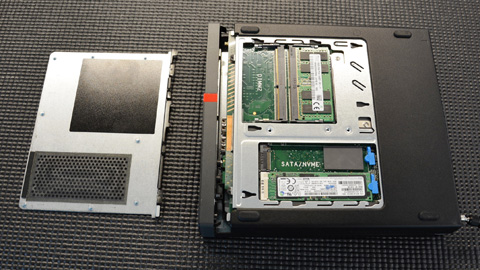
The ThinkStation P320 is designed specifically for space constrained offices.
Lenovo has introduced a micro desktop workstation that is even smaller than the HP Z2 Mini, as reviewed here.
The Lenovo ThinkStation P320 Tiny is only 35mm x 179mm x 183mm in size and 1 litre in volume, which we believe makes it the world’s smallest workstation.
Overall it looks like an attractive proposition for those with space constrained workplaces or those who need a very portable desktop machine that is ISV tested and certified for 2D and 3D CAD.
The ThinkStation P320 Tiny is based on Lenovo’s business PC, the ThinkCentre Tiny. However, while both machines offer the same choice of CPUs – up to the quad core ‘Kaby Lake’ Core i7-7700T – the ThinkStation P320 stands out by offering a much more powerful GPU.
Incredibly, Lenovo has managed to pack in an entry-level professional desktop GPU, the Nvidia Quadro P600. Lenovo reckons this low-profile ‘Pascal’ graphics card delivers approximately 15 – 20 per cent better 3D performance than the Quadro M620, which provides the graphics horsepower in the HP Z2 Mini.


The tiny workstation can be placed in desktop or tower mode
Squeezing a GPU that is designed for Small Form Factor (SFF) workstations into the P320’s micro chasses has taken a significant engineering effort.
First, the GPU is fitted to a riser board, so it sits parallel to the motherboard. Second, Lenovo has removed the GPU’s standard cooler, instead attaching a custom heatsink which connects via copper piping to a single system fan, shared with the CPU.
Like all ThinkStation desktops, the cooling system is designed to draw in cool air at the front of the machine and expel warm air at the back.
While we haven’t seen the ThinkStation P320 Tiny in the flesh, Lenovo reckons fan noise is minimal and is on par with its other desktop workstations.
Despite the compact chassis, Lenovo has placed significant efforts into maintaining serviceability, a hallmark of its larger ThinkStation models.
There is tool-free access to two service panels, one on top and one underneath.
Remove a thumbscrew to slide off the top panel and get access to the CPU and GPU for maintenance and cleaning, while memory and SSD can be easily got at from below.
The workstation can be positioned in desktop or tower mode (with the help of a stand). It can also be secured under the desk or behind a display with custom mounting brackets.
Unlike the HP Z2 Mini, which can take standard quad core Intel Xeon E3 v6 or Core i7 CPUs, up to 73W, the ThinkStation P320 Tiny relies on low-power desktop CPUs, up to the Core i7-7700T, which draws 35W at peak. Clocked at 2.9GHz (Turbo to 3.8GHz) this should still be fine for entry-level to mid-range CAD workflows with applications like SolidWorks, Creo, Revit and AutoCAD.
Additionally, with 4 cores and 8 threads (thanks to HyperThreading) this should also give adequate performance for entry-level physically-based rendering.

Thumb screws removed and top panel slides off.

Top panel removed. The Nvidia Quadro P600 GPU features a custom cooling solution which shares a single fan with the CPU.

Bottom panel removed – provides easy access to memory and storage (M.2 NVMe SSDs)
Other specifications include up to 32GB DDR4 @ 2400MHz (2 SODIMM slots), up to 2TB M.2 NVMe SSD (2 x 1TB) and built-in WiFi.
There are six USB 3.0 (2 at the front, 4 at the rear) four mini DisplayPort, two standard DisplayPort and Ethernet. The 135W power supply is external, taken from a ThinkPad mobile workstation.
There is no 2.5-inch drive, which is one trade off of having such a small chassis. It means that those who want large amounts of storage will have to pay a premium for expensive high capacity SSDs.
However, with models starting at $799 for a dual core Intel Core i3-7100T (3.4GHz), Nvidia Quadro P600, 4GB DDR4 @2400MHz SODIMM memory and a 256GB SSD M.2 NVMe, Lenovo is going aggressive on price. We look forward to reviewing a machine soon.






